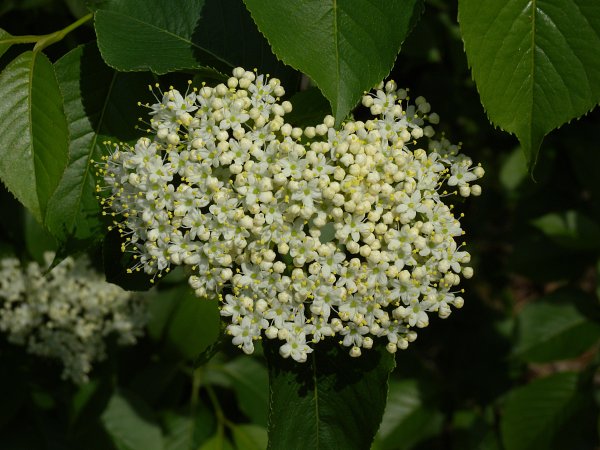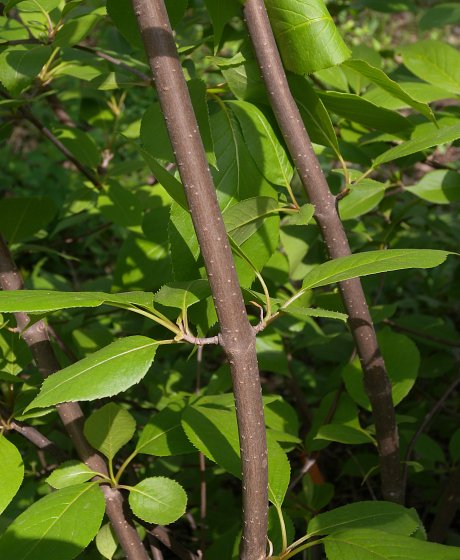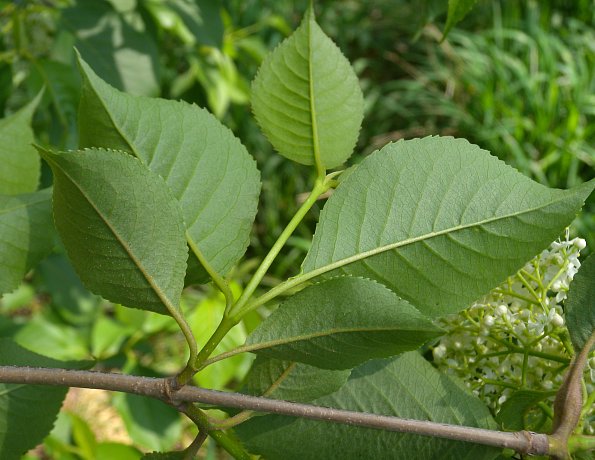
Panicles of flowers about 2-5" across occur at the tips of young shoots; they are slightly dome-shaped above and sessile. Each flower is about ¼" across, consisting of a white corolla with 5 spreading lobes, a light green calyx with 5 teeth, 5 exserted stamens, and a light green pistil with a short style. The lobes of the corolla are oval-shaped, while the teeth of the shallow calyx are triangular-shaped. The stamens have white filaments and yellow anthers. During the blooming period, the branches and pedicels of each panicle are light green, terete, and glabrous (or nearly so); the pedicels of individual flowers are up to ¼" long. The blooming period occurs during late spring for about 2 weeks; the flowers are fragrant. Afterwards, the flowers are replaced by drupes that become mature during late summer or autumn. At this time, the branches and pedicels of the inflorescence turn red. Mature drupes are 6-10 mm. long, ovoid in shape, and dark blue-violet. The fleshy interior of each drupe is somewhat juicy and sweet, tasting like a raisin or date. Each drupe contains a single hard seed (or stone) that is flattened-ovoid in shape and dark-colored. The woody root system is shallow and spreading, often forming clonal offsets. The deciduous leaves of this woody plant become orange, maroon, or dark red during the autumn.

Cultivation: The preference is partial sun, moist to mesic conditions, and fertile loamy soil. However, this woody plant can adapt to other environmental conditions as it is easily cultivated. It is winter-hardy to at least Zone 4.
Range & Habitat: The native Nannyberry is occasional in the northern half of Illinois, where it is native, while in the southern half of the state it is rare or absent (see Distribution Map). Illinois lies along the southern range-limit of this species. Habitats include rocky woodlands, mesic woodlands, low woodlands along streams, thickets, roadsides, and fence rows. Because of its attractive flowers, fruit, and autumn foliage, Nannyberry is occasionally cultivated as an ornamental shrub or small tree. It is found in both higher-quality natural areas and disturbed areas.

Faunal Associations: The nectar and pollen of the flowers attract honeybees, Andrenid bees, Halictid bees (Sphecodes spp. & others), Syrphid flies, dance flies (Empididae), Muscid flies, and miscellaneous beetles (Lovell, 1900; Discover Life, 2015). Other insects feed destructively on the foliage, sap, and other parts of Nannyberry. These insect feeders include Pyrrhalta viburni (Viburnum Leaf Beetle), Lygidea viburni and Lygocoris viburni (Mirid plant bugs), Neoceruraphis viburnicola (Snowball Aphid), Enchenopa binotata (Two-marked Treehopper), and the larvae of such moths as Calledapteryx dryopterata (Brown Scoopwing), Metaxaglaea inulta (Unsated Sallow), and Zale horrida (Horrid Zale); see Clark et al. (2004), Knight (1941), Hottes & Frison (1931), Covell (1984/2005), Wagner (2005), and Discover Life (2015). The fruits of Nannyberry are eaten by many upland gamebirds and songbirds, including the Ruffed Grouse, Northern Bobwhite, Ring-necked Pheasant, Northern Flicker, Gray Catbird, American Robin, Hermit Thrush, Eastern Bluebird, Cedar Waxwing, Rose-breasted Grosbeak, and Purple Finch (DeGraaf, 2002). Birds that use Viburnum spp. as sites for their nests include the White-eyed Vireo, Indigo Bunting, Prairie Warbler, and Catbird. Some mammals also use Viburnum spp. as sources of food. They include such species as the White-tailed Deer (twigs & foliage), Cottontail Rabbit (bark), American Beaver (wood), Eastern Chipmunk (fruits), Fox Squirrel (fruits), Gray Squirrel (fruits), Red Fox (fruits), and White-footed Mouse (fruits); see Martin et al. (1951/1961).

Photographic Location: Busey Woods in Urbana, Illinois.
Comments: This is one of the larger Viburnum spp. Nannyberry (Viburnum lentago) resembles Blackhaw Viburnum (Viburnum pruinoides), except its leaves have more narrow tapering tips and its petioles are narrowly and irregularly winged. There is also a tendency for the young shoots and petioles of Blackhaw Viburnum to be more red and its leaves to be more yellowish green during the late spring when the flowers of both species are in bloom. The leaves of these two Viburnum spp. are more finely serrated than the coarsely toothed leaves of Smooth Arrow-wood (Viburnum recognitum) and other arrow-wood species. In addition, the flowers of both Nannyberry and Blackhaw Viburnum have a pleasant fragrance and their drupes are sweet and edible. In contrast, the flowers of Smooth Arrow-wood and other arrow-woods have an unpleasant fragrance and their drupes have an unpleasant taste. Another common name of Viburnum lentago is Sweet Viburnum.